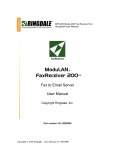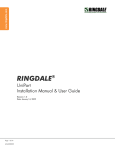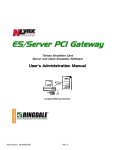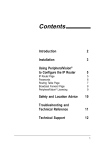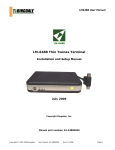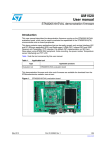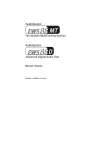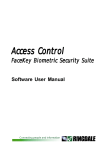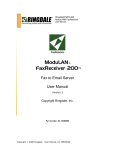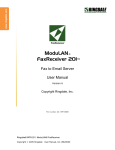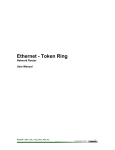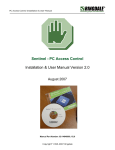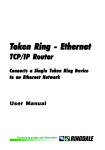Download Energy Monitor Guide
Transcript
® RINGDALE 1569 Energy Monitor and Energy Analyzer Application Quick Integration Guide Ethernet Version Revision: 1.09 Date: May 20, 2015 Page 1 of 42 1569 Energy Monitor and Energy Analyzer Application User Manual Copyright, Disclaimer and Trademarks Copyright Copyright 1997-2008 © Ringdale, Inc. All rights reserved. No part of this publication may be reproduced, transmitted, transcribed, stored in a retrieval system, or translated into any language or any computer language, in any form or by any third party, without prior permission of Ringdale UK Limited. Disclaimer Ringdale, Inc. reserves the right to revise this publication and to make changes from time to time to the contents hereof without obligation to notify any person or organisation of such revision or changes. Ringdale, Inc has endeavoured to ensure that the information in this publication is correct, but will not accept liability for any error or omission. NOTE: Because of the fast pace of software development it is possible that there will be minor differences between the manual and the actual release of the program. Trademarks All trademarks are hereby acknowledged. Page 2 of 42 1569 Energy Monitor and Energy Analyzer Application User Manual Table of Contents Copyright, Disclaimer and Trademarks ..................................................................................................... 2 Table of Contents Introduction .................................................................................................................. 3 Introduction ................................................................................................................................................ 4 Energy Monitor Hardware ..................................................................................................................... 4 Energy Analyzer Application ................................................................................................................. 5 Configure ............................................................................................................................... 5 Program ............................................................................................................................................ 5 Monitor ................................................................................................................................... 5 Connecting an Energy Monitor.................................................................................................................. 6 Programming Location .......................................................................................................................... 6 Once programmed and ready to install ................................................................................................ 6 Configuring an Energy Monitor ................................................................................................................. 8 General ................................................................................................................................ 10 TCP/IP ............................................................................................................................................ 11 E-mail Settings ............................................................................................................................... 13 Time and Date ................................................................................................................................ 15 CT Select .....................................................................................................................................................16 Debug ............................................................................................................................................. 17 Controlling the Energy Monitor ........................................................................................................... 18 Listen to Device ..........................................................................................................................................18 Manual Control ..................................................................................................................... 19 Records Panel ............................................................................................................................................20 Incoming Records .......................................................................................................................... 20 Save Records..............................................................................................................................................20 Log Records ................................................................................................................................................21 Programming an Energy Monitor ............................................................................................................ 22 Program Device .................................................................................................................................. 23 Sample Frequency ......................................................................................................................................23 Start and Stop Times ..................................................................................................................................24 Monitor Mode ....................................................................................................................... 25 Alarms ............................................................................................................................................ 26 Setting up an Energy Monitor – Using a Web Browser .......................................................................... 27 Configuration ............................................................................................................................ 28 Configuration - General Settings ................................................................................................... 28 Configuration – Password .............................................................................................................. 28 Configuration – TCP/IP .................................................................................................................. 29 Configuration – E-Mail Settings ..................................................................................................... 30 Configuration – Time and Date ...................................................................................................... 31 Configuration – CT Select .............................................................................................................. 32 Configuration – Reset to Defaults .................................................................................................. 32 Programming....................................................................................................................................... 33 Monitor Control ......................................................................................................................... 34 Start or Stop Monitor Now.............................................................................................................. 34 Status .................................................................................................................................................. 34 Contents .............................................................................................................................................. 35 About ................................................................................................................................................... 36 Collecting Monitor Records ..................................................................................................................... 37 Output files............................................................................................................................................... 38 Technical Specifications .......................................................................................................................................39 Records Definitions ............................................................................................................................. 39 Glossary ................................................................................................................................................... 41 Technical Support Contact Information................................................................................................... 42 Page 3 of 42 1569 Energy Monitor and Energy Analyzer Application User Manual Introduction The Energy Monitor is a 3-phase current transformer data logger with either an Ethernet or a USB interface. The Energy Monitor may be programmed to monitor various different aspects of electrical power. An application is required to set up the Energy Monitor and to analyse the various types of readings it will produce. The application has multiple modes of operation. It is first used to set up the Energy Monitor so that it may collect data. Later it is used to retrieve and analyse that data. It may also analyse data as it arrives in real time. The part number for the Ethernet version of the product is 00-11-0569-0000. For the USB Version, see part number 00-11-0569-0001. Energy Monitor Hardware The Energy Monitor is available with either an Ethernet or a USB interface. Ethernet Connected The device is connected to a LAN and may be powered by either PoE or a 12V supply. In this mode the unit may send emails or other alerts when programmed conditions are encountered or in response to a programmed schedule. Data may be transmitted on the LAN and also stored on an external flash drive. The User interface will be through either the Energy Analyzer application or with a web browser. USB Flash Drive Data may be transmitted to the computer for storage and/or stored on an external flash drive. The Energy Monitor offers a USB port for connection of a Flash Drive. Data samples will be written to a compatible Flash Drive as they are obtained and may be viewed and analysed later. The Flash Drive may be removed (when safe to do so) and plugged directly into a PC for data analysis using the EnergyAnalyzer application. The Flash Drive must use the ‘USB Mass Storage Class’ with a sub-class of ‘SCSI transparent’ and the transport protocol ‘Bulk-Only Transport’. Examples of Flash Drives that use these standards are: Ringdale USB 2.0 1GB Pretec I-Disk SanDisk 1GB Cruzer Micro Toshiba 2GB Verbatim 8GB (formatted for 2GB) The Flash Drive must be formatted as FAT or FAT16. The Energy Monitor expects a file named “DATALOG.BIN” in the root directory and the data area of that file to be contiguous. Once created, the same file will be re-used. Do not move or copy the file on the drive as this may result in fragmentation and the possible corruption of the disk storage structures. The file size determines the maximum number of samples that may be stored within it. At the maximum file size of 512MB, approximately 16.7 million data sample records may be stored, 19.4 days when sampling at a 1/10 second frequency. Page 4 of 42 1569 Energy Monitor and Energy Analyzer Application User Manual Energy Analyzer Application The Energy Analyzer Application is used to configure, program and monitor one or more devices. Configure The term “configure” means setting up the Energy Monitor’s name, TCP/IP, E-mail, and Time & Date parameters. Program This refers to instructing the Energy Monitor when to start sampling and how often. Monitor This function is used to 1) set the application to listen to the device, 2) set it to collect records and determine where the record file is kept, and 3) whether to save records and/or logs. Records are binary data. Log Records are interpreted records that are readable text. Page 5 of 42 1569 Energy Monitor and Energy Analyzer Application User Manual Connecting an Energy Monitor Types of Service Supported Supported electric services include 50 or 60-hertz, alternating current, single-phase or three-phase. Nominal secondary voltages are listed below: Type Volt(nominal) Single-phase, Single-phase, 100 to 240-Volt, two-wire, grounded 120/240-Volt, three-wire, grounded Three-phase, Three-phase, 208Y/120-Volt, four-wire, grounded, wye 10 385Y/220-Volt, four-wire, grounded, wye 10 Three-phase, Three-phase, 420Y/230-Volt, four-wire, grounded, wye 10 480Y/277-Volt, four-wire, Delta 11 US 3 phase mainly Germany high power users, In Germany also used as Household Power. mainly UK, Canada, Australia high power users mainly US Three-phase, 208 to 480-Volt, three wire, Delta US, Europe, Japan high power user Page 6 of 42 1569 Energy Monitor and Energy Analyzer Application User Manual Conductors Mode Description 00 00 Mainly Japan and US small user power mainly US Household power 01 Programming Location For convenience, an Energy Monitor should be configured before locating it at the place where it will be coupled to the power lines. Although this is not mandatory, there may not be easy access to the network. For the purpose of programming, connect the device to the network in any convenient location. Connect the power supply into the wall socket and the Energy Monitor. Once programmed and ready to install 1) Plug in the USB Flash Drive if you have it. 2) If Ethernet is available, plug the Ethernet cable into the RJ45 jack. Note: Power over Ethernet (PoE) cables are limited to a maximum of 36 feet. When not using PoE: You can connect up to a maximum of 100 Meters (328 feet, 109 yards) for 100baseT or 500 meters (1500 feet) for 10baseT. Page 7 of 42 1569 Energy Monitor and Energy Analyzer Application User Manual IMPORTANT NOTE: The user should exercise caution in connecting the voltage and current inputs since the connection points may be live. It would be best to disconnect power when connecting but that may not be practical in all cases. Inspect the voltage and current sensing cables for damaged insulation and exposed conductors before each use and do not use if damage is found. Replacement voltage cables and current transformers may be purchased from Ringdale and current transformers with damaged cables may be returned for repair. 3) There is only one way to connect the voltage and current sensing cables to the Energy Monitor: ./ ./ ./ ./ The current transformers clip around current-carrying conductors and connect to the Energy Analyzer at the AØ, BØ, and CØ Current inputs. The red and green connectors are used to measure voltage. The green connects to the neutral (grounded) conductor. The red wires connect to each of the 3 voltage phases. The red wire adjacent to the green wire is for the AØ. The next red wire is the BØ. The last red wire is the CØ. 4) Unless using PoE, connect the power supply into the wall socket and the Energy Monitor. Page 8 of 42 1569 Energy Monitor and Energy Analyzer Application User Manual Configuring an Energy Monitor Network configuration of an Energy Monitor device may be done using the Energy Analyzer Application or a web browser. Basic setup includes setting the device IP address, specifying the e-mail server address and destination e-mail recipients for alert messages. For configuration using a web browser, please go to page 14. To use the application, please read on. Start the Energy Analyzer Application. A device must first be selected. Click “Select Device”. Any Energy Monitors on your network will show up in the panel as shown above. If it doesn’t appear straight away, use the Requery Network button to try again to find the device. Click on the device that is to be configured to highlight it and then click the OK button. If you have a USB version of the Energy Monitor, select that tab to see it. Use the Select a File for a previously saved file. Page 9 of 42 1569 Energy Monitor and Energy Analyzer Application User Manual IMPORTANT NOTE: All Energy Monitors are shipped with a factory default IP address of 11.22.33.44. To avoid TCP/IP conflicts, only one device that has not been configured should be connected to the network at a time. Once selected, the device’s name will appear in the main panel and the three options “Connect Selected Device”, “Configure Selected Device”, and “Program Selected Device” will become available. The first step is to configure the Energy Monitor’s name, TCP/IP, E-mail, and Time & Date parameters. Click on the up. Configure Selected Device Page 10 of 1569 Energy Monitor and Energy Analyzer Application User Manual button and the Configure Network Device panel will come General The General tab allows you to modify the device name and set or change a password. It also shows the Hardware model and Firmware revision. Page 10 of 42 1569 Energy Monitor and Energy Analyzer Application User Manual TCP/IP This tab is used to assign the Energy Monitor with an appropriate IP address for your network. It also allows you to set the IP addresses that the Energy Monitor will contact for e-mail sending and accurate time keeping. When changing the IP address of the Energy Monitor, it is best to make just that change first, then go back to “Select Device” to re-select the device using its new IP address, and then make the other changes. 1) Enter an unused IP Address from your network, or click on the DHCP/RARP Enable. NOTE: If you change to an address that is NOT in the same network range that your PC is, you will still be able to see the Energy Monitor with the Energy Monitor utility, but you will not be able to change any parameters until you are on the same subnet. 2) If you are not using DHCP or RARP, enter the Subnet Mask. 3) If you are not using DHCP or RARP, set the Default Gateway. 4) DNS Servers, 1 and 2, are the Domain Name Servers provided by your ISP. It is used to convert the Mail Server SMTP Address’s URL to an IP Address. Page 11 of 42 1569 Energy Monitor and Energy Analyzer Application User Manual 5) If you have a DNS server defined, the Mail Server SMTP Address can be entered either as a URL (for example smtp-server.austin.rr.com) or an IP Address. Using the URL is recommended if you may be changing your network, and you have your own mail server. 6) Time Server IP 1,2, & 3. You can either set the time manually on the Time and Date panel or configure up to three preferred timeservers. Without the correct time, the timestamp will be incorrect on all records, and if you email Alert conditions, your spam filter may trap the email. The 192.043.244.018 address is the timeserver at NCAR. TIME SERVER NOTE: All timeservers send the time UTC. In order to set the time stamps correctly you must adjust your Time Zone Offset under the Time and Date tab. There is a list of public timeservers at this URL: http://tf.nist.gov/service/time-servers.html Page 12 of 42 1569 Energy Monitor and Energy Analyzer Application User Manual E- mail Settings The e-mail settings are used to send an Alert message if certain triggers are met. 1) Mail Server SMTP Address – Use the TCP/IP tab to change this. 2) Mailserver SMTP IP Port – The default is 25. This is most common. Other common ports used are 26, and 2525. 3) Mailserver Login Name – Often this is an email address. When a fax is received in the email box, it will come from this user. Max 58 characters. 4) Mailserver Login Password – This is the password for the above email account. There is a maximum of 58 characters. NOTE: case-sensitive. 5) Reply e-mail Address – If the person who receives the fax does a reply, it will go to this address. 6) Reply Name – This is the name that shows in the email header when you receive a fax. 7) Destination e-mail Address(es) - This is where the email will be sent. This can be the same as item 2) or it may be an alias set up to forward to multiple users. Simply enter the addresses you wish to send to as one entry, each address separated by either a semi-colon (;) or a Page 13 of 42 1569 Energy Monitor and Energy Analyzer Application User Manual comma (,). There is a limitation of a maximum of 80 characters for all addresses. No spaces are allowed. Enter each address on a new line. Page 14 of 42 1569 Energy Monitor and Energy Analyzer Application User Manual Time and Date The Energy Monitor features a battery backed up clock. When first set up and periodically after, the clock may be (re) synchronized with a time server or the PC running the Energy Analyzer application. If at least one Time Server IP address has been specified, the Energy Monitor will automatically contact a Time Server to keep its clock accurate. Note that it will not adjust its clock while it is monitoring to avoid spoiling the record sequence. The “Set Device Time From PC Clock” function allows you to synchronize the device time with the PC time. This option is only available if no Time Servers have been specified. TIME SERVER NOTE: Some local timeservers and all Internet timeservers send the time in UTC. In order to set the time stamps correctly you may need to adjust your Time Zone Offset and select or de-select the Daylight Savings Enable option. Page 15 of 42 1569 Energy Monitor and Energy Analyzer Application User Manual CT Select Select the value of the current transformers that you are using. Page 16 of 42 1569 Energy Monitor and Energy Analyzer Application User Manual Debug The Energy Monitor keeps a log of various messages. This panel is useful only if a problem should arise, at which time obtaining the recent messages may prove informative. Under normal circumstances there is no need to use this panel. Page 17 of 42 1569 Energy Monitor and Energy Analyzer Application User Manual Controlling the Energy Monitor Select the device to monitor and connect to it using the Connect Selected Device button. When successfully connected the Actions buttons will become available. Listen to Device This will tell the Energy Monitor to send a copy of each sample record to you. If the device is not actually running, then you will not receive any records. Sample records will still be recorded into a flash drive if fitted, regardless of this setting. Page 18 of 42 1569 Energy Monitor and Energy Analyzer Application User Manual Manual Control This window only stays up for 30 seconds. The eight buttons give you the choice of action you want the device to take. Start and Stop Sampling are normally used to begin and end a sampling session if there is no automatic start and stop Time and / or Date defined. When the Energy Monitor is running, the Stop Sampling button must be used before removing a flash drive to ensure that the sample record file is closed properly, and to ensure that the flash drive can safely be removed. Pause and Resume are used where sampling is temporarily stopped. IMPORTANT NOTE: The flash drive should not be removed while the device is running or paused. Removal of the flash drive without stopping the unit may result lost data of up to 16 of the last records sampled. Device Status This button will show you the status of the Energy Monitor but is currently not implemented. Use the web interface to get status of the sampling and the levels of each channel. Page 19 of 42 1569 Energy Monitor and Energy Analyzer Application User Manual Records Panel Incoming Records The device must be in Listen mode by selecting the Listen to Device button. You must also set the device to sample records either manually or using the Program Start/Stop Times. Save Records Put a check in the Save Records box to bring up the location where the records binary file will be kept. If you select the same name as a previously saved bin file, it will be overwritten. The device must be in Listen mode by selecting the Listen to Device button. You must also set the device to sample records either manually or using the Program Start/Stop Times. Page 20 of 42 1569 Energy Monitor and Energy Analyzer Application User Manual Log Records Put a check in the Log Records box to bring up the location where the records binary file will be kept. If you select the same name as a previously saved bin file, it will append to the previous data. The device must be in Listen mode by selecting the Listen to Device button. You must also set the device to sample records either manually or using the Program Start/Stop Times. About Click on the About button to find the version of the EnergyAnalzer software. Page 21 of 42 1569 Energy Monitor and Energy Analyzer Application User Manual Programming an Energy Monitor Sample records will be recorded into a flash drive (if one is plugged in) as soon as either the Manual Control / Start Sampling has been selected or it is between the Start Time and Stop Time. Click on the Program Selected Device button to call up the Program Device panel. Page 22 of 42 1569 Energy Monitor and Energy Analyzer Application User Manual Program Device Sample Frequency The sample frequency determines how often a sample is reported. At 18000, one sample is taken every 30 minutes. At 10, one sample is taken per second. At 1, ten samples are taken per second. Page 23 of 42 1569 Energy Monitor and Energy Analyzer Application User Manual Start and Stop Times Each of the Start and Stop Times, Start Date and Stop Date may be given a value or left undefined. Leave all of these values undefined if you intend to start and stop the device manually. Specifying Start and Stop times but leaving the Dates undefined will set a repetition pattern. It is possible to define the Start Time as 9:00 pm and the Stop Time as 6:00 am for monitoring through each night if the dates are left undefined, or for a particular night or nights if the dates are defined. Specifying a Start Date without specifying a Start Time, and the same for the Stop values, will have no effect. NOTE: If Start and Stop times defined, you will not always be able to start and stop the device manually. For example, if the device is programmed to start at 4:00 pm and stop at 10:00 pm, the device will automatically restart if manually stopped between 4:00 pm and 10:00 pm. Similarly, manually starting the device after 10:00 pm will result in an automatic stop. As a rule, it is better to not define Start and Stop times if you wish to manually start and stop the unit, or to re-program with undefined times prior to manually starting or stopping. Page 24 of 42 1569 Energy Monitor and Energy Analyzer Application User Manual Monitor Mode The initial option is RMS Voltage and Current with Accumulated Watt Hours. Other Monitor Mode options may be available by requesting through Technical Support. Email [email protected]. Page 25 of 42 1569 Energy Monitor and Energy Analyzer Application User Manual Alarms You can set an Alert to be sent to the Destination Email Address when monitoring starts and/or stops. Future revisions will current/voltage threshold triggers. Page 26 of 42 1569 Energy Monitor and Energy Analyzer Application User Manual Setting up an Energy Monitor – Using a Web Browser Open the Home page of the device. In our example here the device has an IP address of 205.242.238.124. Note: You need to be on the same virtual network (subnet) as the device in order to be able to communicate with it. The upper panel shows the device description and the name currently assigned to the device – “Energy Monitor” in our example. Page 27 of 42 1569 Energy Monitor and Energy Analyzer Application User Manual Configuration Configuration is used for setting up the Energy Monitor’s name, TCP/IP, E-mail, and Time & Date parameters. It also will allow you to change the password, download firmware, and reset to defaults. Configuration - General Settings This section allows you configure a unique name for each Energy Analyzer that you have. Page 28 of 42 1569 Energy Monitor and Energy Analyzer Application User Manual Configuration – Password Page 29 of 42 1569 Energy Monitor and Energy Analyzer Application User Manual Configuration – TCP/IP IP Address – Enter an unused IP Address from your network, or click on the DHCP/RARP Enable. NOTE: If you change to an address that is NOT in the same network range that your PC is, you will still be able to see the Energy Monitor with the Energy Monitor utility, but you will not be able to change any parameters until you are on the same subnet. Subnet Mask – Enter the subnet mask. DHCP can be used if you do not use static IP addresses on the network. Gateway IP is the default gateway. DNS Server 1,2 – DNS Servers can be used to resolve the Mail Server IP from the URL. Mail Server IP/URL - If you will be configuring the Energy Monitor to report threshold trigger events, you must enter an IP Address for the SMTP mail server. Page 30 of 42 1569 Energy Monitor and Energy Analyzer Application User Manual Configuration – E-Mail Settings Mail Server SMTP Address – Use the TCP/IP tab to change this. Mail Server SMTP IP Port – The default is 25. This is most common. Other common ports used are 26, and 2525. Mail Server Login Name – Often this is an email address. When a fax is received in the email box, it will come from this user. Max 58 characters. Mail Server Login Password – This is the password for the above email account. There is a maximum of 58 characters. NOTE: case-sensitive. Reply e-mail Address – If the person who receives the fax does a reply, it will go to this address. Reply Name – This is the name that shows in the email header when you receive a fax. Destination e-mail Address(es) - This is where the email will be sent. This can be the same as the Mail Server Login Name or it may be an alias set up to forward to multiple users. Simply enter the addresses you wish to send to as one entry, each address separated by either a semi-colon (;) or a comma (,). There is a limitation of a maximum of 80 characters for all addresses. Max 80 characters. No spaces are allowed. Enter each address on a new line. Page 30 of 42 1569 Energy Monitor and Energy Analyzer Application User Manual Configuration – Time and Date The Time and Date option brings up the Clock Setting options and the current time. You can either select time servers, or set the time and date manually. If the time is not set correctly the timestamp will be incorrect and your spam filter may trap the email. Time Server IP 1,2, & 3 – You can either set the time manually or use time servers. You can add up to three time servers. TIME SERVER NOTE: There is a list of public time servers at this URL: http://tf.nist.gov/service/timeservers.html Time Zone Offset – All time servers send the time UT. In order to set the time stamps correctly you must adjust your Time Zone Offset. This is the offset from UT. If you are in Greenwich, England, this number will be 0. If your time zone is east of Greenwich, England), the number is positive. If your time zone is west of GMT, the number is negative. For EST, use –5, CST –6, MST –7, PST –8, AKST –9, and HAST – 10. Page 31 of 42 1569 Energy Monitor and Energy Analyzer Application User Manual Configuration – CT Select The CT Select option brings up the CT Selection menu where you can select either 150 Amp or 30 Amp Current Transformers. Configuration – Reset to Defaults This will normally only be used under the direction of Technical Support. It will not change the IP Address of the Energy Monitor. Page 32 of 42 1569 Energy Monitor and Energy Analyzer Application User Manual Programming The Programming option brings up the following Programming page. Sample Frequency The sample frequency determines how often a sample is reported. At 18000, one sample is taken every 30 minutes. At 10, one sample is taken per second. At 1, ten samples are taken per second. The default value is 20, the equivalent to a 2 second sample rate. Start / Stop Times Each of the Start and Stop Times, Start Date and Stop Date may be given a value or left undefined. Leave all of these values undefined if you intend to start and stop the device manually. Specifying Start and Stop times but leaving the Dates undefined will set a repetition pattern. It is possible to define the Start Time as 9:00 pm and the Stop Time as 6:00 am for monitoring through each night if the dates are left undefined, or for a particular night or nights if the dates are defined. Page 33 of 42 1569 Energy Monitor and Energy Analyzer Application User Manual Specifying a Start Date without specifying a Start Time, and the same for the Stop values, will have no effect. NOTE: If Start and Stop times defined, you will not always be able to start and stop the device manually. For example, if the device is programmed to start at 4:00 pm and stop at 10:00 pm, the device will automatically restart if manually stopped between 4:00 pm and 10:00 pm. Similarly, manually starting the device after 10:00 pm will result in an automatic stop. As a rule, it is better to not define Start and Stop times if you wish to manually start and stop the unit, or to re-program with undefined times prior to manually starting or stopping. Monitor Mode There are two fundamental monitor modes the first being the smallest record size recording only the basic information of voltage, current and watt hours occupying 32 bytes per record and thus allowing to store the maximum amount of records on the USB Flash drive. The extended mode records in addition reactive power and VA. Page 34 of 42 1569 Energy Monitor and Energy Analyzer Application User Manual Alarms Page 35 of 42 1569 Energy Monitor and Energy Analyzer Application User Manual Control The Control Panel provides access to Waveform and Montor Control Functions. The Monitor Control option brings up the following Monitor Control page. Start or Stop Monitor Now Start and Stop are normally used to begin and end a sampling session. Pause and Resume are used where sampling is temporarily stopped. IMPORTANT NOTE: The flash drive should not be removed while the device is running or paused. Removal of the flash drive without stopping the unit may result in corrupted data. Page 36 of 42 1569 Energy Monitor and Energy Analyzer Application User Manual Status Click the Status option to verify if the unit is running or not. Page 37 of 42 1569 Energy Monitor and Energy Analyzer Application User Manual Contents Clicking on Contents brings up an Index page. The functions on this page are the same as those on the Home page. Page 38 of 42 1569 Energy Monitor and Energy Analyzer Application User Manual About This page provides information about the unit. Page 39 of 42 1569 Energy Monitor and Energy Analyzer Application User Manual Collecting Monitor Records Data Records may be obtained from one of three sources, 1) from a Network device, 2) from a USB device and 3) from a folder that includes the file from the USB flash drive that has been written by the device. Records should be considered to come in a stream. The Energy Monitor may be started and stopped manually using the Manual Control panel, or it can be programmed to start and/or stop automatically at certain times and dates. You can take the compact flash; plug it into a PC with the EnergyAnalyzer for analysis. This is the procedure: 1) Take the compact flash, plug it into a PC. 2) Open the EnergyAnalyzer application. Click the Select Device button, then the Select A File tab 3) Click the Browse button and choose the datalog.bin 4) Click Connect Selected Device. 5) Put a check in Log Records. Provide a file name for the text file. 6) Click Listen to Device to see the data go by. The text file is space delimited. When it is done you can import the file into Excel and generate a chart. USB Flash Device The only USB Flash devices supported are up to 2GB with FAT format 2048 bytes per sector. The filename is DATALOG.BIN and is not case sensitive since version 1.10. The file should be pre-formatted with all 0xFF for the length of the file. However the file gets overwritten on every power-up of the device. Since version 1.12 The device will always append data to the end of previously recorded data. To erase the data use a PC to reformat and re-apply the preformatted datalog.bin file. Page 40 of 42 1569 Energy Monitor and Energy Analyzer Application User Manual Output files Sample log file: Date 08/03/07 08/03/07 08/03/07 08/03/07 08/03/07 08/03/07 08/03/07 08/03/07 08/03/07 08/03/07 08/03/07 08/03/07 08/03/07 08/03/07 08/03/07 08/03/07 08/03/07 Time 12:39:11.499 12:39:13.499 12:39:15.499 12:39:17.499 12:39:19.499 12:39:21.499 12:39:23.499 12:39:25.499 12:39:27.499 12:39:29.499 12:39:31.499 12:39:33.499 12:39:35.499 12:39:37.499 12:39:39.499 12:39:41.499 12:39:43.499 IA 0.2124 0.2017 0.2029 0.2048 0.2193 0.2080 0.2004 0.2067 0.2055 0.1979 0.2080 0.2061 0.2080 0.2023 0.2092 0.2017 0.2029 IB 0.1941 0.2061 0.2174 0.2168 0.2010 0.2092 0.2162 0.1998 0.2136 0.1960 0.1985 0.2143 0.2111 0.2067 0.1941 0.1947 0.1960 IC 0.1960 0.1985 0.1847 0.1973 0.1966 0.2036 0.1985 0.1954 0.1992 0.1966 0.2036 0.2029 0.1865 0.1809 0.1985 0.1941 0.1985 VA 1.5327 1.5327 1.5327 1.5327 1.5321 1.5327 1.5327 1.5327 1.5327 1.5327 1.5327 1.5321 1.5327 1.5327 1.5327 1.5327 1.5321 IA-IC = Current readings for channel A-C. VA-VA= Voltage readings for channel A-C. WH=Watt/Hours for channel A-C. Page 41 of 42 1569 Energy Monitor and Energy Analyzer Application User Manual VB 12.6650 12.6650 12.6650 12.6650 12.6650 12.6650 12.6650 12.6643 12.6650 12.6643 12.6643 12.6650 12.6643 12.6643 12.6650 12.6650 12.6650 VC 7.0988 7.0988 7.0988 7.0988 7.0988 7.0988 7.0988 7.0982 7.0988 7.0988 7.0988 7.1789 7.0988 7.0988 7.1789 7.1789 7.1789 WHA 00000 00000 00000 00000 00000 00000 00000 00000 00000 00000 00000 00000 00000 00000 00000 00000 00000 WHB WHC 00000 00000 00000 00000 00000 00000 00000 00000 00000 00000 00000 00000 00000 00000 00000 00000 00000 00000 00000 00000 00000 00000 00000 00000 00000 00000 00000 00000 00000 00000 00000 00000 00000 00000 Technical Specifications Power Supply Power Input Power Consumption Operating Temperature LAN Connection Network Type Data Collection External All Voltage 12..48 Volt DC, 1A 3 watts typical –40°C to +85°C RJ-45 Ethernet 10/100baseTx USB Thumb Drive or via Ethernet to a PC running application Records Definitions This is the general record description. It is beneficial to programmers performing an analysis of the .bin record file. struct dataloggerRecord { BYTE rectype; BYTE length; // length following USHORT dateStamp; // 16 bit date stamp ULONGtimeStamp; // 32bit 1/32768sec count from midnight BYTE data[length - 6]; }; 5.3 powerRecord // // Record Type == 0 // RMS Power consumption monitor // struct powerRecord { BYTE rectype = 0; BYTE length = 30; USHORT dateStamp; ULONGtimeStamp; BYTE phaseACurrent[3]; BYTE phaseBCurrent[3]; BYTE phaseCCurrent[3]; BYTE phaseAVoltage[3]; BYTE phaseBVoltage[3]; BYTE phaseCVoltage[3]; BYTE phaseAWattHr[2]; BYTE phaseBWattHr[2]; BYTE phaseCWattHr[2]; }; // // Record Type == 1 // Alarm Page 42 of 42 1569 Energy Monitor and Energy Analyzer Application User Manual // 24bit Phase A current RMS // 24bit Phase B current RMS // 24bit Phase C current RMS // 24bit Phase A voltage RMS // 24bit Phase B voltage RMS // 24bit Phase C voltage RMS // 16bit Phase A Watt-Hour Accumulation // 16bit Phase B Watt-Hour Accumulation // 16bit Phase C Watt-Hour Accumulation // to be specified // // Record Type == 2 // Waveform data // struct waveRecord { BYTE rectype = 2; BYTE reserved; USHORT dateStamp; ULONGtimeStamp; BYTE waveData[16][3]; }; waveRecords will come in batches of 32 records Notes For non waveRecord types: dateStamp is bit packed yyyyyyymmmmddddd timeStamp is 1/32768sec from midnight For waveRecord type: To be specified Page 40 of 42 1569 Energy Monitor and Energy Analyzer Application User Manual // 6x x 24bit values Current Transformers (CT) This is a specification for current transformers useable with the Ringdate Energy Monitor. Current transformers can be purchased in a wide range of clamp sizes and rated current configurations from the Ringdale Online Store. Note: Only use CTs with burden resistors for Ringdale Energy Monitor Device. Part No. Rated Current (Amps) 00-11-0750-0000* 0-200 00-11-0750-0005 5 00-11-0750-0010 10 00-11-0750-0015 15 00-11-0750-0020 20 00-11-0750-0025 25 00-11-0750-0030 30 00-11-0750-0050 50 00-11-0750-0060 60 00-11-0750-0070 70 00-11-0750-0100 100 00-11-0750-0150 150 00-11-0750-0200 200 *Products with -0000 have no burden resistor. Page 41 of 42 1569 Energy Monitor and Energy Analyzer Application User Manual Dimension (inches) A B C D E 2.00 2.10 0.61 0.75 0.75 The following table shows the output voltage of the versus the percentage of 'Rated Current' (see table above). Page 42 of 42 1569 Energy Monitor and Energy Analyzer Application User Manual Glossary CT Current Transformer is the device used to determine the amount of current flow based on the electrical induction of the wire. For a list of purchasable 333mV current transformers see the Ringdale website. IEC The International Electrotechnical Commission is the international standards and conformity assessment body for all fields of electrotechnology. NCAR National Center for Atmospheric Research NPMP Network Peripheral Management Protocol, a protocol developed by Ringdale for communicating with Ringdale devices. NTP Network Time Protocol - It uses ports 123 for TCP and UDP. RMS Root Mean Square - The RMS value is the effective value of a varying voltage or current. USB Universal Serial Bus A widely used hardware interface for attaching peripheral devices Page 43 of 42 1569 Energy Monitor and Energy Analyzer Application User Manual Technical Support Contact Information Ringdale, Inc. 101 Halmar Cove Georgetown Texas 78628 USA リングデール株式会社 (Ringdale, KK) 〒100-0005 東京都千代田区丸ノ内1-8-3 丸ノ内トラストタワー本館 20階 Toll-free: +1 888-288-9080 Phone: +1 512-288-9080 Fax: +1 512-288-7210 Web: www.ringdale.com Web: www.ringdale.co.jp Ringdale (UK) Ltd. 26 Victoria Way Burgess Hill West Sussex RH15 9NF United Kingdom Ringdale Singapore No.1 Sims Lane #04-06 Singapore 387355 Freephone: 0800 214503 Phone: +44 (0) 1444 871349 Fax: +44 (0) 1444 870228 Web: www.ringdale.co.uk Page 44 of 42 1569 Energy Monitor and Energy Analyzer Application User Manual 電話(代表): 03-5288-5310 / FAX: 03-6800-5316 Phone: +65 6749 2285 Fax: +65 6749 5095 Web: www.ringdale.com

















































